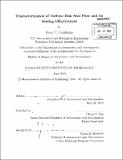Characterization of turbine rim seal flow and its sealing effectiveness
Author(s)
Catalfamo, Peter T
DownloadFull printable version (5.120Mb)
Other Contributors
Massachusetts Institute of Technology. Department of Aeronautics and Astronautics.
Advisor
Choon S. Tan.
Terms of use
Metadata
Show full item recordAbstract
In a gas turbine engine, ingestion of hot gas from the flowpath into the gaps between the turbine rotor and stator can lead to elevated metal temperatures and a deterioration of component life. To prevent ingestion, bleed air from the compressor is used to "purge" the rim seal cavities. Establishing a quantitative understanding of the wheelspace and rim cavity flow processes driving ingestion is critical to optimizing seal design and minimizing the associated performance penalty. A computational model of the wheelspace that does not limit the spatial or temporal scales of flow processes is formulated. This allows the assessment of the response of the wheelspace to external stimuli set up by the turbine main flow path, and the development of causal links between flow processes and their drivers. Varying the axisymmetric turbine flowpath pressure on a quasi-steady basis when the purge flow supply seal is choked has no impact on ingestion; the pressure field in the wheelspace merely scales with the flowpath pressure, leaving the flow structure unchanged. Introducing circumferential variation in the external pressure field can, however, lead to ingestion with the ratio of disturbance wavelength to the trench depth emerging as a key parameter. Varying rotational speed alone does not drive ingestion as a stagnation point is formed on the outer shroud that is ingestion resistant. It is shown that excitation at frequencies corresponding to the natural modes of the wheelspace system can lead to large responses in pressure and seal flow rate, with the seal reduced frequency appearing as a characterizing parameter. The existence and parametric dependence of these modes is further assessed through a small disturbance flow analysis. A generalized small disturbance flow analysis is formulated that provides a direct enumeration of the key characterizing parameters.
Description
Thesis (S.M.)--Massachusetts Institute of Technology, Dept. of Aeronautics and Astronautics, 2013. This thesis was scanned as part of an electronic thesis pilot project. Cataloged from PDF version of thesis Includes bibliographical references (p. 83-84).
Date issued
2013Department
Massachusetts Institute of Technology. Department of Aeronautics and AstronauticsPublisher
Massachusetts Institute of Technology
Keywords
Aeronautics and Astronautics.